- 1ERCE, Calgary, AB, Canada
- 2ERCE, London, United Kingdom
At COP28, Carbon Capture, Utilization, and Storage was declared a removal technology whose application must be accelerated. In 2017, the Society of Petroleum Engineers (SPE) published the CO2 Storage Resource Management System (SRMS) as a framework for stakeholder communication. The SRMS guidelines were designed to support the creation of reports that inform readers regarding the contingencies that must be overcome to obtain project approval, uncertainty in the mass of CO2 that can be stored, and the commerciality of the project. However, working examples where the SRMS has been used to communicate project status in the public domain are limited. In 2023, the authors of this paper referred to the SRMS as the standard for completing an expert report, termed a Competent Persons Report (CPR), for the Viking Carbon Capture and Storage (CCS) development in the United Kingdom. During the application of the SRMS framework, challenges were identified in conveying the progress made by the project proponent in identifying and addressing technical risks. This paper describes innovations developed to supplement the SRMS guidelines and improve communication with stakeholders. First, a flowchart was developed to explain a vital interpretation of the SRMS. Next, a defined framework of technical milestones was designed to assess the maturity of a given technical topic within the SRMS. This framework was combined with radial data visualization. The combination allowed multiple storage sites to be compared simultaneously and allowed stakeholders to quickly identify the maturity of technical analysis for any given site. We conclude that improving the consistency and clarity of CCS reporting to stakeholders can help build trust in this emerging industry.
1 Introduction
How does a new industry build trust, especially a complex one like CCS? In this industry, many stakeholders, from regulators to the public to emitters, need to trust that a storage site will be both effective and safe.
Many articles have been published about establishing trust in corporate activities (Esser, 2021; Ryan, 2022; Vitasek et al., 2022). A constant across all recommendations is clear communication. Easy to say but difficult to achieve, clear communication embraces clarity, compassion, competency, connection, and consistency (Shapira and Horsager, 2022).
Industries build frameworks and guidelines as tools for engaging with people and communicating ideas. These tools can be found in virtually any sector. As an extreme example, within strategic consulting, frameworks are even made to summarize frameworks (Reeves et al., 2015).
Within the extractive resource industries, guidelines that help explain contingencies that must be overcome to obtain project approval, uncertainties in the amount of resource that can be extracted and the commerciality of the project play a vital role. They connect an industrial project or portfolio of projects to stakeholders via formal reporting that uses the guideline. In mining and oil and gas, some of these guidelines have been in use for decades to engage in activities such as:
• Annual Reporting
• Debt facilities, such as Reserve Based Lending (RBL)
• Bond and Equity Initial Public Offerings (IPOs)
• Supporting contracts
• Communicating projects and project values to owners
The following are examples of guidelines and frameworks currently in use in extractive industries (SPE, 2018; SPEE, 2018; CIM, 2019; JORC, 2012):
• Society of Petroleum Engineers (SPE) Petroleum Resource Management System (PRMS)
• Society of Petroleum Evaluation Engineers Canadian Oil and Gas Engineering Handbook (COGE Handbook)
• Canadian Institute of Mining, Metallurgy and Petroleum (CIM) Metals Mineral Resources Mineral Reserves (MRMR) Best Practice Guidelines
• Australasian Code for Reporting of Exploration Results, Mineral Resources and Ore Reserves (JORC Code)
These guidelines are so well established that they are part of securities regulation. Be it in Canada under the NI 51-101 or NI 43-101 rules, Europe with European Securities and Markets Authority (ESMA) rules, the United Kingdom with the London Stock Exchange (LSE) rules, or Australia and the Australian Stock Exchange (ASX) rules, it is typical for reports conforming to required guidelines to be mandated as a method of investor communication (Canadian Securities Administrators, 2015; Canadian Securities Administrators, 2016; ASX, 2022; LSE, 2009; ESMA, 2011; ASX, 2013; ESMA, 2013; NPD, 2001; SEC, 2009; The Financial Services Authority, 2002).
In Europe, these reports are often referred to as CPRs. In other countries they may have different names, such as an “expert report” or an “independent reserves and resources report” or a “qualified persons report.” This paper will use the term CPR to refer to all such reports globally.
Securities regulations govern who can author these reports. Typically, the authors of CPRs must be registered members of securities-regulator-approved professional bodies1. The authors are usually professional engineers and geoscientists with wide experience in technical and commercial matters related to the type of industrial activity they report on. CPR authors must also have demonstrable independence from project proponents. The securities regulator of the exchange under which their reports are issued typically oversees CPR authors and the work they produce.
Given their decades of use, the mineral extraction industries have well-established uses of CPRs. They serve as a communication tool for the mineral project developer (the company that extracts the mineral) to engage with those who ultimately own the commodities (usually governments), as well as those who finance commodity development and buy the commodities. In turn, these stakeholders use the information to make decisions, including whether to invest and how to establish and manage contracts (Figure 1).
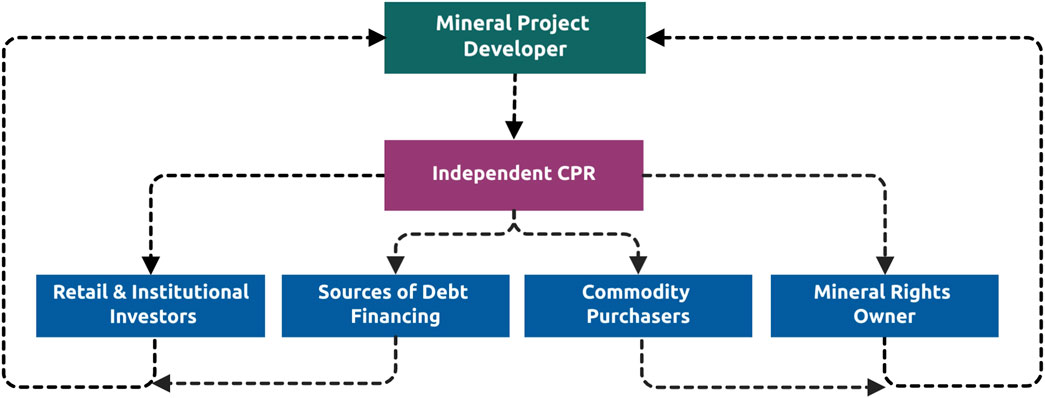
Figure 1. Example communication pathways when a mineral developer commissions a CPR. Figures 1 through 7 and select text in this paper used with permission of Society of Petroleum Engineers (SPE), from A Novel Approach to Communicate a CO2 Storage Resources Management System Classification Framework, Chernik, PS., Caniggia, M., SPE-215752-MS, 2023; permission conveyed through Copyright Clearance Center, Inc.
In the energy transition, additional industries that need guidelines and frameworks to communicate with stakeholders are expanding. A leader in developing new guidelines is the United Nations, which has created a framework designed to support any resource industry (UNECE, 2020). Industry-specific guidance has been developed for the geothermal industry (Delbert et al., 2010; AGRCC, 2010; National Renewable Energy Laboratory, 2021). Within the CCS industry, aside from UN efforts, several guidelines have also been developed2 (SPE, 2017; International Organization for Standardization, 2017; Akhurst et al., 2021; DNV, 2021).
As of July 2024, there have been only a handful of CCS disclosures to equity markets, referencing CCS guidelines and frameworks. Examples include those by Santos (Wilson et al., 2023) and Pilot Energy (Pilot Energy, 2024) in Australia, Wintershall DEA in Denmark (Wintershall, 2020), Novatek in Russia (NOVATEK, 2022) and Harbour Energy in the United Kingdom (Harbour Energy, 2023).
Aside from public equity disclosures, there is evidence of CCS guidelines (meant to support reporting of contingencies, uncertainties and commerciality) playing a role in regulatory processes in the United Kingdom (UK DESNZ, 2023a), Canada (DNV, 2010) and Norway (NOD, 2024).
In 2023, the authors of this paper referred to the SRMS as the standard to complete a Competent Person’s Report (CPR), referred to by Harbour Energy in their disclosure to the London Stock Exchange (Harbour Energy, 2023).
Using the SRMS as a tool for stakeholder communication was challenging. Specifically, it was difficult to communicate the progress the project proponent had made in addressing technical contingencies (technical risks) within the SRMS classification of Contingent Storage Resources.
As a result of the challenges encountered, supplementary methods were developed, beyond those described explicitly in the SRMS, to improve communication. First, a flowchart was developed to explain a vital interpretation of the SRMS. Second, a defined framework of technical milestones was developed to assess the maturity of a given technical topic within the SRMS. The milestones were designed to convey the progress toward a complete risk system, Monitoring Measurement and Verification (MMV) plan, and Corrective Measures (CM) plan. Finally, the framework was combined with radial data visualization. The combination allowed multiple storage sites to be compared simultaneously and allowed stakeholders to quickly identify the maturity of technical analysis for any given site.
We believe this to be a simple but significant innovation in the applicability of the SRMS as a tool to communicate project status and the pace of addressing risks. First, the ability to systematically categorize the maturity of technical work in relation to an approved risk system, MMV, and CM plans allows for ease of comparison of projects. This is important for companies with large CCS portfolios, as it facilitates finance and mergers and acquisition (M&A) activity and helps regulators compare different activities within their jurisdiction. Second, the ability to visualize the progress of technical work across significant lines of analysis, highlighted by the SRMS, will allow managers and stakeholders to gain a consistent appreciation of project progress. This will aid in decision-making regarding where to allocate resources or estimate project timelines.
2 Carbon capture and storage – a unique resource industry
CCS has the potential to grow into a significant global industry (Holloway, 1996). COP28 declared it to be a key technology whose use needs to be accelerated (UNFCCC, 2023a) to achieve climate change goals. This declaration was consistent with the findings of the Intergovernmental Panel on Climate Change (IPCC), which identified CCS as a necessary mitigating technology to fight climate change (Metz et al., 2005; Shukla et al., 2022). The scale of the potential demand for CCS is significant, with an estimated 5,600 mega-tonnes per annum needed by 2,050 (Global CCS Institute, 2021). In 2023, it was estimated there were 26 CCS facilities under construction and 325 projects at various levels of development (Global CCS Institute, 2023b). Given government support through actions like the United Kingdom industrial carbon capture and storage business model (UK DESNZ, 2023b), the United States 45Q tax support for CCS (Bright, 2021), the EU Industrial Carbon Management Strategy (European Commission, 2024), and plans in a host of other countries including Saudi Arabia and Malaysia, (IEA, 2023; Global CCS Institute, 2023a) these project counts are likely to grow.
Alongside the growth of the CCS industry is an increasing need for stakeholder communication. Thus, guidelines and standards are being developed for CCS, as in other resource industries. As examples, the SPE, International Organization for Standardization (ISO), and the United Nations have all published guidelines and standards (SPE 2017; UNECE, 2016; International Organization for Standardization, 2017). In academia, a proposed Storage Readiness Level framework can be found (Akhurst et al., 2021). There are even private sector standards published by DNV (DNV, 2021).
However, CCS has a few key factors that differentiate it from other resource industries:
1. It is the opposite of the extractive industries. As the name says, rather than taking from the environment, CO2 is stored. Therefore, the resource of a given project is its capacity to store CO2.
2. CO2 store sites do not extract a material to be sold. Instead, CO2 storage is a service. The services may be provided to internal CO2 emitters as part of a vertically integrated project. Or the service may be offered to external CO2 emitters, who pay to access the store site. Some are also arguing that CO2 storage is such an essential service it should be considered a public good and funded through tax bases (The University of Edinburgh, 2021).
3. Final Investment Decisions (FID) for CO2 storage sites do not necessarily need the project to be economic. Traditional resource projects expect certain financial thresholds to be met. For example, typical investment worthy projects require a positive Net Present Value (NPV) accounting for cost of capital. However, CCS is a mitigation method that supports efforts in the fight against global warming. Therefore, FID may be taken, and the project may be treated as commercial, even if the CCS investment is sub-economic. Objectives other than economics might drive the investment decision. Examples include organizational decarbonization targets, regulatory requirements, or corporate financing tied to portfolio emissions reduction. A sub-economic investment may then become economic through the generation of voluntary carbon credits (Verra, 2022).
a. Whether a given CCS investment is economic is often a question of project boundaries. Is the project a dedicated CCS site? Is CCS treated as an incremental project3 to an existing industrial activity? Or is it treated as part of the lifecycle costs of a new industrial development that does more than just CCS?
The unique nature of CCS projects means that there are a new range of stakeholders who will potentially use a CPR.
Figure 2 highlights how there is currently no regulated use of injection frameworks to engage with investors in the equity markets. This holds for a variety of injection projects, including CO2, CH4, and H2. Figure 3 is an example of where a Storage Resource CPR could fit within a stakeholder group (note this is not meant to be an exhaustive list of potential stakeholders).
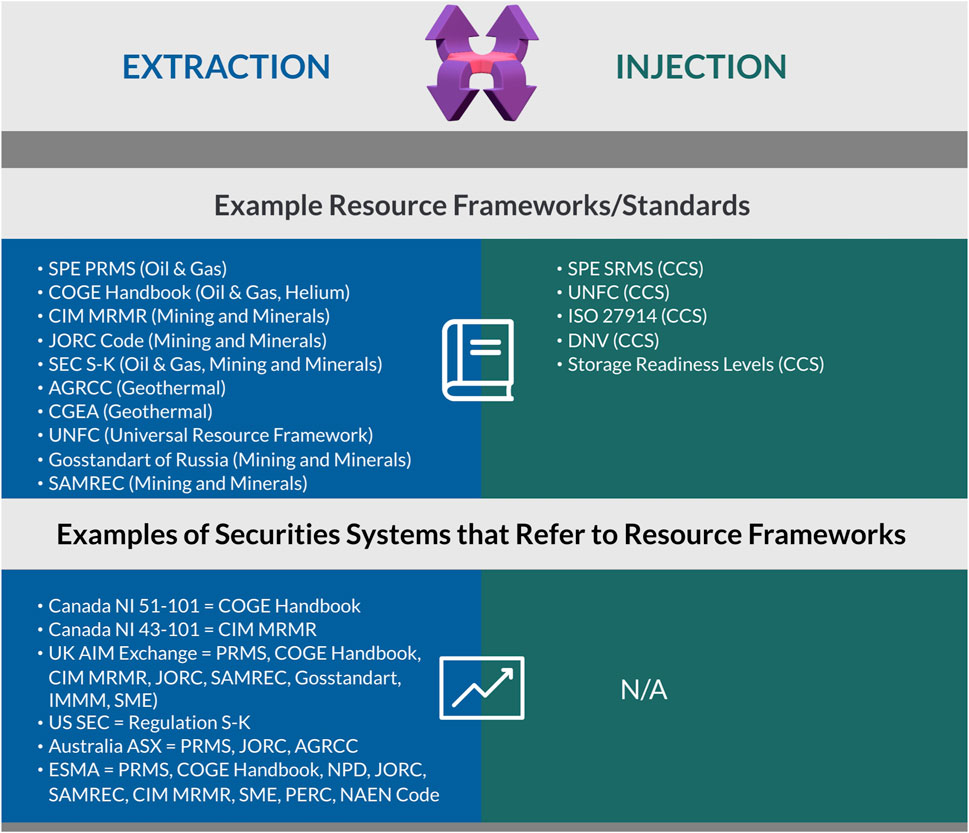
Figure 2. Public equity reporting frameworks and standards for resources in extraction industries and injection industries. Figures 1 through 7 and select text in this paper used with permission of Society of Petroleum Engineers (SPE), from A Novel Approach to Communicate a CO2 Storage Resources Management System Classification Framework, Chernik, PS., Caniggia, M., SPE-215752-MS, 2023; permission conveyed through Copyright Clearance Center, Inc.
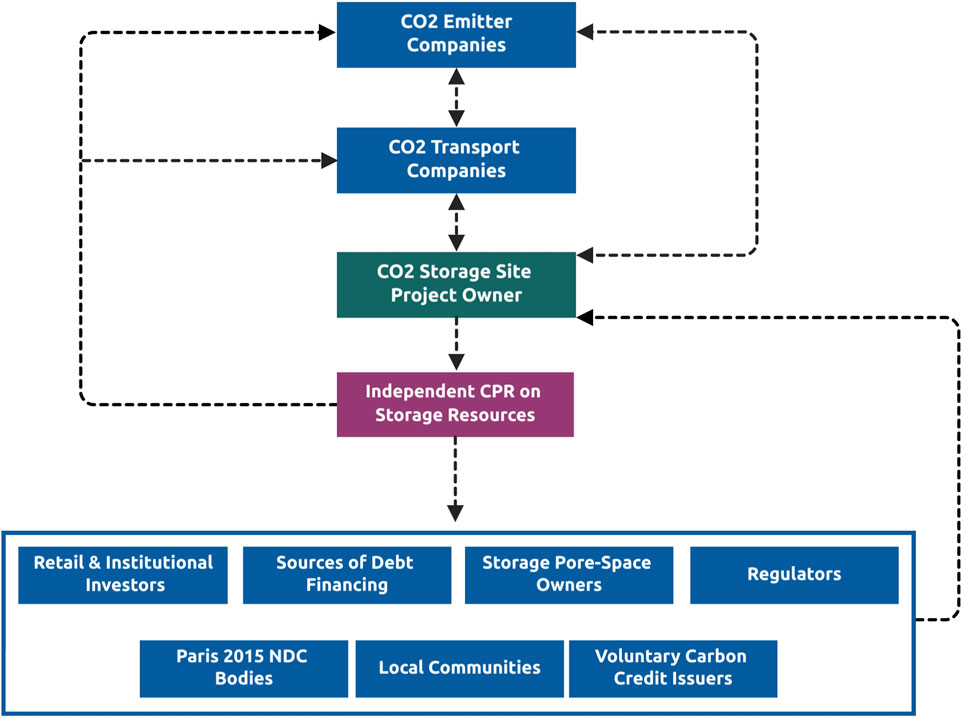
Figure 3. Example communication pathways where a CCS storage provider commissions a CPR. Figures 1 through 7 and select text in this paper used with permission of Society of Petroleum Engineers (SPE), from A Novel Approach to Communicate a CO2 Storage Resources Management System Classification Framework, Chernik, PS., Caniggia, M., SPE-215752-MS, 2023; permission conveyed through Copyright Clearance Center, Inc.
Important aspects to note from Figure 3 include:
1. Upstream of the storage site project owner are the emitter of CO2 and the transporter of CO2. These are critical stakeholders in a CCS system. They provide the supply of the CO2 to the storer, and rely on the store site to take their CO2 at the agreed rates and volumes. Communication is flowing constantly between these emitters, the transporters and the storer.
a. In some cases, a single corporation may be two or all three stakeholders. In other cases, it may be multiple companies.
2. There are a host of new stakeholders that may require, or benefit from, access to a CPR. These include voluntary carbon credit issuers, pore space owners and organizations involved with monitoring Nationally Determined Contributions (UNFCCC, 2023b).
3 An early application of the SPE SRMS
In late 2022, a CPR was commissioned for the offshore storage related to the Viking CCS Project, United Kingdom (Harbour Energy, 2023; Viking CCS, 2023). The CPR used the SPE SRMS (SPE, 2017) as the standard to evaluate the project. This CPR was believed to be the first reported to the European equity markets according to the SRMS standard. It was also one of the earliest CPRs written after the publication of the 2022 SRMS Application Guidelines (SPE, 2022).
As such, when applying the SRMS, there was no custom or practice regarding measuring a project against the standard. There was also no common understanding of the terminology in the SRMS standard amongst stakeholders who would access the report.
Stakeholders were considered when executing the CPR mandate. Particular attention was paid to the fact that, for many readers, this would potentially be the first CPR they had ever had access to. With the variety of new stakeholders involved in CCS (Figure 3), all types of readers needed to be considered, each with varying levels of CCS knowledge.
Thus, clearly communicating what the SRMS framework requires and how projects are mapped to the framework was treated as a critical need in writing the report.
3.1 Implementing the SRMS
Early in the project, a key challenge was noted concerning CO2 Storage Projects – there are irreducible risks that can never be eliminated. Instead, risks are identified (typically in a risk register), planned for, and incorporated into the Measurement, Monitoring and Verification (MMV) plan and Corrective Measures (CM) plan4. Regulators are establishing MMV and CM frameworks that companies will operate under (NSTA, 2022; NSTA, 2023; Alberta Government, 2022; EPA, 2024b; IEA, 2022).
As such, Technical Contingencies (Figure 4), are an area of considerable focus in CCS projects. Technical Contingencies are integral to the CCS licence application process with regulators. They are incorporated into a formal risk assessment process where CCS operators complete detailed studies to understand the likelihood and severity of the Technical Contingency. Then, each contingency is formally addressed and, where appropriate, incorporated into the MMV and CM plans.
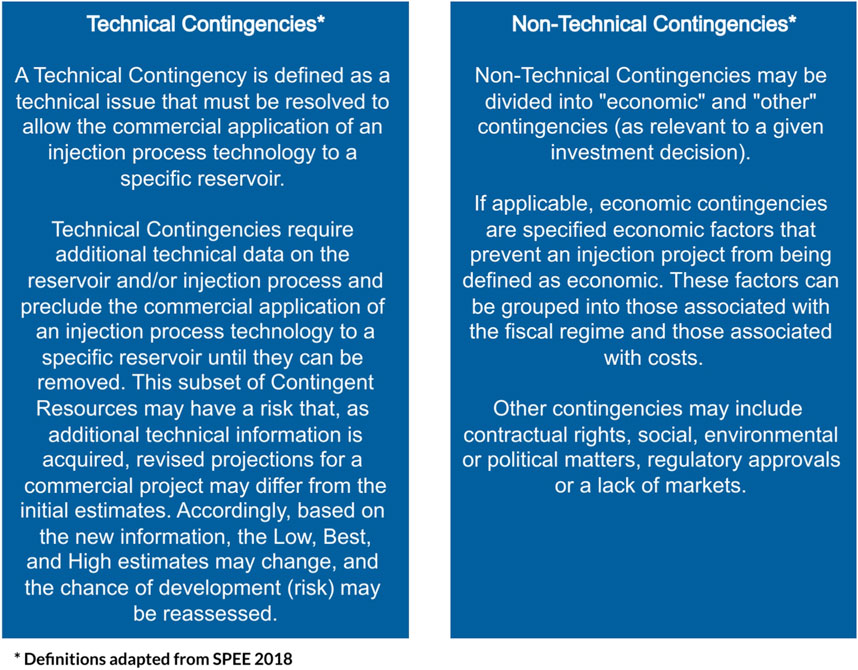
Figure 4. Definitions of technical and non-technical contingencies. Figures 1 through 7 and select text in this paper used with permission of Society of Petroleum Engineers (SPE), from A Novel Approach to Communicate a CO2 Storage Resources Management System Classification Framework, Chernik, PS., Caniggia, M., SPE-215752-MS, 2023; permission conveyed through Copyright Clearance Center, Inc.
Technical evaluations of CCS can be broadly treated as studies on the mass of CO2 that can be stored, the ability to inject the CO2 at required rates, and the ability to contain the CO2 (Wilson et al., 2023). Underlying all study work is an understanding of how injecting CO2 increases pressure and how pressure impacts a storage project.
Our review of the SRMS identified that the SRMS recommends eight broad technical “Topics” to be addressed during the evaluation of a storage project:
1. Legacy well containment
a. Assessment of leakage potential of CO2 and in situ fluids via legacy wells within the storage complex and surrounding area.
2. Geological containment
a. Vertical and lateral containment of CO2 and in situ fluids.
3. Geomechanical modelling
a. Assessment of geomechanical modeling and integration into containment and injectivity.
4. Injectivity
a. Includes factors that impact CO2 injection rate, such as phase behavior, skin, and injection pressure limits (pressure local to a well and at a reservoir scale).
5. Volumetric method
a. Total storage resources (TSR), storable quantity, or pore volume estimates using the volumetric method, if relevant.
6. Material balance method
a. TSR, storable quantity, or aquifer extent estimates using the material balance method, if relevant.
7. Reservoir simulation method
a. Numerical simulation models on which plume, pressure distributions and/or storable quantities are based.
8. Facilities development
a. Includes topside/onshore facilities, subsea infrastructure, umbilicals, risers and flowline analysis (as appropriate) within an integrated development plan.
Each of these eight topics comprises many technical sub-topics that need to be studied, often over months or even years. Each topic has Technical Contingencies (Figure 4).
When an independent audit or evaluation is commissioned to the SRMS standard for a CPR, the following guidance is provided to project proponents: “The supporting data, analytical processes, and assumptions used in an evaluation should be documented in sufficient detail to allow an independent evaluator or auditor to clearly understand the basis for estimation and categorization of storable quantities and their classification” (SPE, 2017, 8).
Thus, in an SRMS process, our interpretation of the guidelines is that the author of a CPR is expected to study the information available on the project, and be able to frame that information within the eight technical topics listed above (as applicable). Then, they must be able to “classify” and “categorize” the project5.
Guidance on the types of studies and information required to classify and categorize a project are found in the Guidelines for applications of the CO2 SRMS (SPE, 2022). However, the state of progress towards a commercial project is a professional determination made by the CPR authors, independent of the project proponent.
As such, it is critically important that the authors of CPRs worldwide have a consistent method of assessing and presenting the maturity of the technical analysis as it relates to understanding project risk.
3.2 Barriers to using the SRMS framework as a communication tool
Traditionally, in extractive resource industries, frameworks use project maturity subclasses such as “Development Unclarified,” “Development On-Hold” and “Development Pending” to explain progress toward commerciality (SPEE, 2018; SPE, 2018). These are also referred to in some detail in the SRMS Application Guidelines (SPE, 2022, 9). For ease of reference, they are presented in Figure 5.
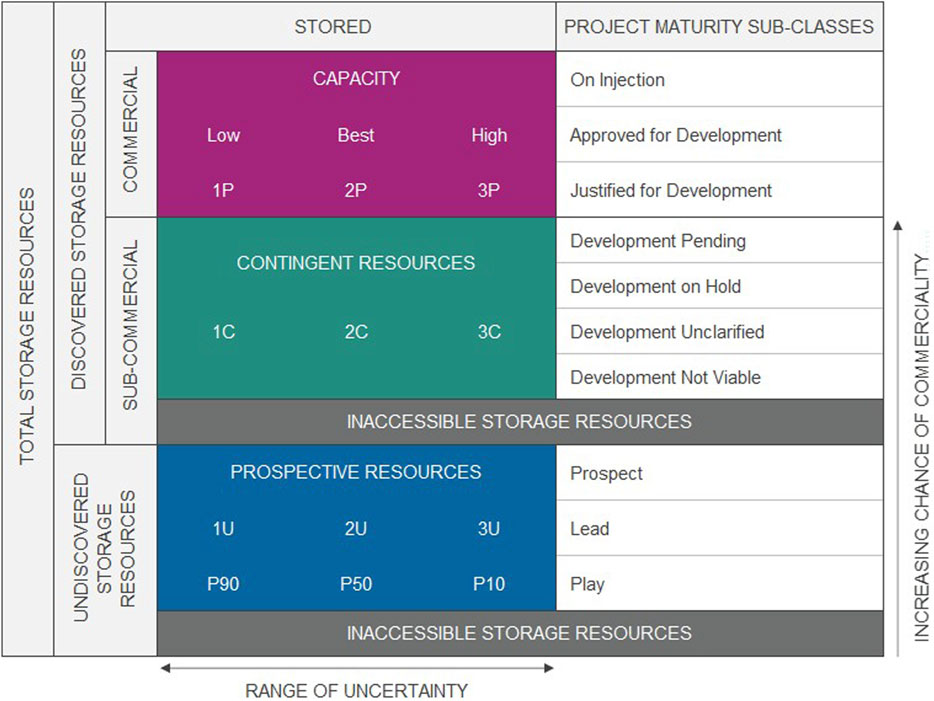
Figure 5. Recreated image from the SPE SRMS framework with sub-classes. Figures 1 through 7 and select text in this paper used with permission of Society of Petroleum Engineers (SPE), from A Novel Approach to Communicate a CO2 Storage Resources Management System Classification Framework, Chernik, PS., Caniggia, M., SPE-215752-MS, 2023; permission conveyed through Copyright Clearance Center, Inc.
The above are established terminology for oil and gas extraction projects, where a commercial project is also economic. However, as mentioned earlier, a positive NPV (accounting for cost of capital) in CCS may not be necessary for a final investment decision. In addition, projects may spend years in the Development Unclarified category as technical studies are completed to understand whether a site is technically suitable for CCS, before any Non-Technical Contingencies (Figure 4) are addressed.
As such, we found the SRMS framework challenging to use as a tool to explain the maturity of technical analysis as the project advanced towards FID, allowing for the range of stakeholders engaged in CCS. The reasons were as follows:
• SRMS currently provides definitions of the subclassifications but does not explain the path a site can take along the vertical axis. ERCE noted stakeholders, particularly those unfamiliar with reserves and resources assessment from extractive industries, assumed it was a linear progression along the y-axis of Figure 5. However, this is rarely the case.
• The available subclasses in SRMS lack the level of granularity necessary to explain progress in the eight technical topics (Section 3.1). The SRMS framework does not discuss the relationship between risk identification, an MMV plan, a CM plan, and the SRMS subclassifications. Yet, we found that explaining the progress of technical studies in relation to addressing project contingencies (risks) was an important need for users of our report.
• The report we delivered had several CCS sites within it. We found it difficult to relate the progress of various sites using only words. All fit within the contingent resources classification, and many fit within the same subclassification. Yet the amount of technical study work completed on each site was not equal, as some sites had received more hours of analysis than others, as of the report’s effective date.
3.3 A flow diagram to explain project maturity sub-classes
Our first challenge was explaining to stakeholders the context of the project maturity subclasses related to CCS. The SRMS lacks the descriptive flow charts found in other systems, that explain the decision-making process for contingent resource sub-classification. Such examples can be found in the COGE Handbook (SPEE, 2018; Figure 1-8).
A flowchart was therefore constructed to explain the relationship between study work and sub-classes to new stakeholders. A decision was taken to use the “Development Unclarified” subclass (Figure 6) as the step in which critical Technical Contingencies are identified and either addressed or incorporated into future planning. This is consistent with the United Kingdom NSTA’s approach to applying the SPE SRMS. The NSTA has mapped their “Assess Phase” of the Carbon Storage licensing process to SRMS Development Unclarified (Kennedy and Moore, 2023).
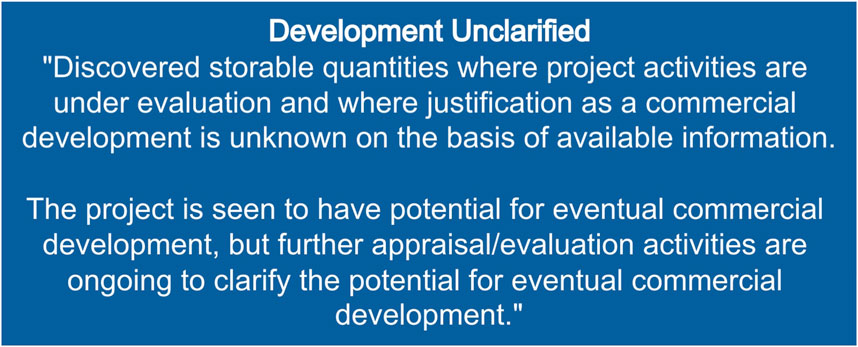
Figure 6. SPE SRMS 2017 Definition of development unclarified. Figures 1 through 7 and select text in this paper used with permission of Society of Petroleum Engineers (SPE), from A Novel Approach to Communicate a CO2 Storage Resources Management System Classification Framework, Chernik, PS., Caniggia, M., SPE-215752-MS, 2023; permission conveyed through Copyright Clearance Center, Inc.
Technical studies can and do occur at any point during the project journey from Contingent Resources to Capacity. However, in our application of the SRMS we elected to state that sufficient technical work was required in each of the eight Topics, where relevant, to indicate that no “show-stoppers” existed. In other words, before progressing out of development unclarified, sufficient work was completed so that something very unusual would have to be identified (from a technical perspective) at later stages of development to move the project to Non-Viable.
The resultant flow diagram is presented in Figure 7.
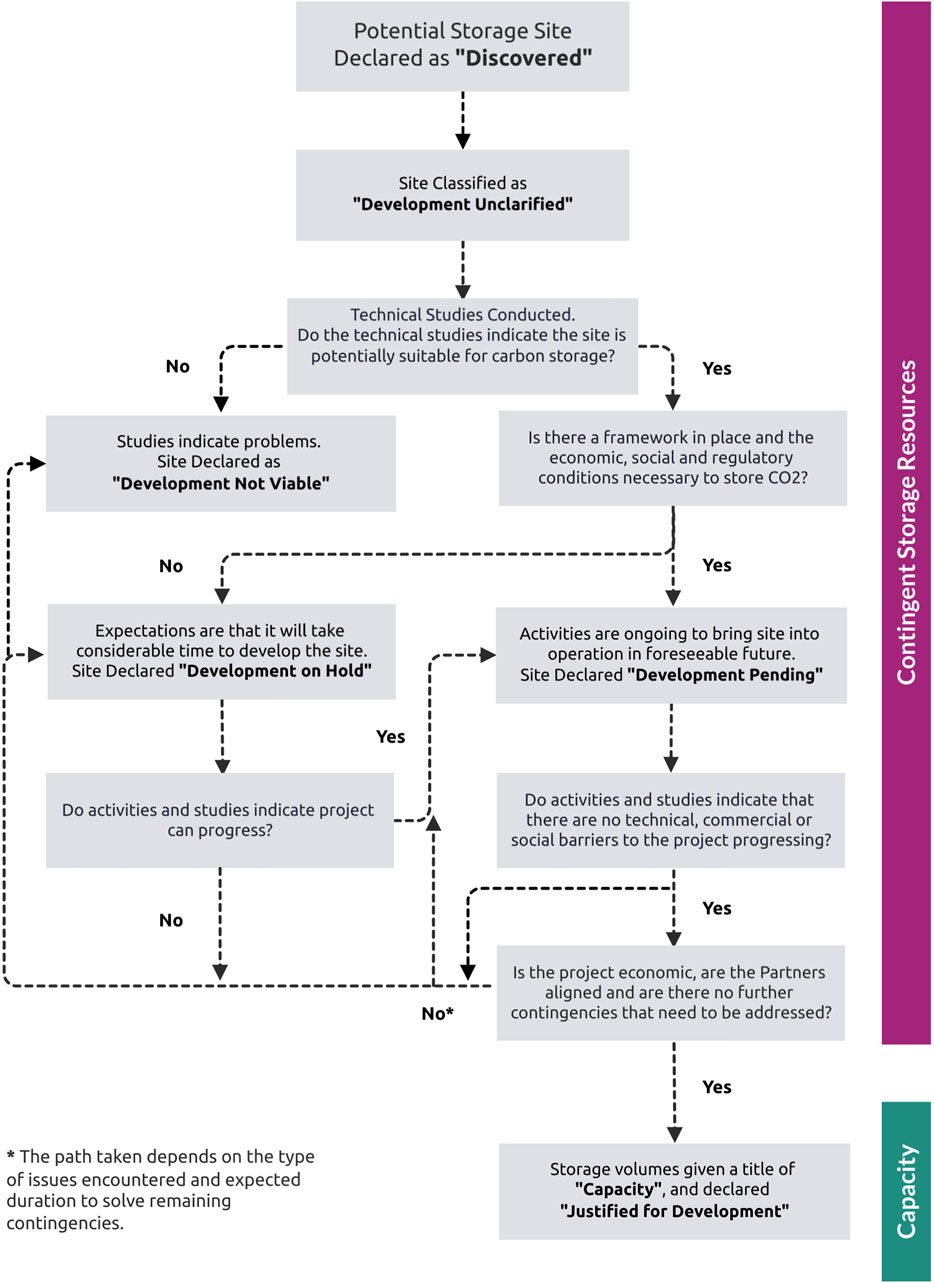
Figure 7. Flowchart to describe the relationship between SRMS contingent resources sub-classes. Figures 1 through 7 and select text in this paper used with permission of Society of Petroleum Engineers (SPE), from A Novel Approach to Communicate a CO2 Storage Resources Management System Classification Framework, Chernik, PS., Caniggia, M., SPE-215752-MS, 2023; permission conveyed through Copyright Clearance Center, Inc.
3.4 A new technical maturity framework developed
With this flowchart complete, our next challenge was to develop a methodology that would allow us to systematically categorize the maturity of technical work done to date, in each of the eight topics.
The framework was developed to link:
• Data gathering
• Technical studies
• The MMV and CM plans
It was also built to recognize that CCS developments can incorporate multiple storage sites. Each site can represent a different project, and these can be progressed at different rates. Yet, stakeholders need to be aware of the technical maturity of the multiple projects at once, to understand the relative progress of the CCS developments.
The framework incorporated six technical maturity steps (Figure 8). Each technical topic is assigned a maturity ranking as of the report’s effective date. We have found that at a given date, some topics, such as reservoir simulation, may be very advanced. In contrast, other topics, such as legacy wells or facilities analysis may be at a much earlier stage. Assigning a numerical value helps stakeholders understand the level of progress of technical work in each topic so that appropriate questions may be asked and to temper expectations regarding answers.
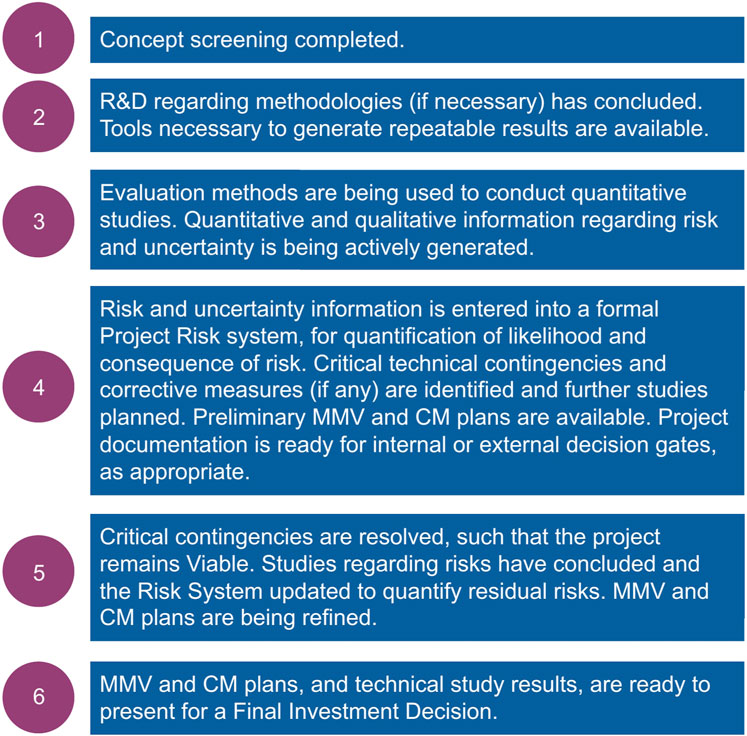
Figure 8. CCS technical maturity framework. Figures 1 through 7 and select text in this paper used with permission of Society of Petroleum Engineers (SPE), from A Novel Approach to Communicate a CO2 Storage Resources Management System Classification Framework, Chernik, PS., Caniggia, M., SPE-215752-MS, 2023; permission conveyed through Copyright Clearance Center, Inc.
When assigning a ranking, the project technical topic must satisfy a step’s criteria before being assigned to that step. The exception is step 3, which can be assigned while a company is carrying out the requirements under step 3.
In broad terms, at the end of step 1, the expectation is the project proponent has screened existing data and taken a high-level view if they think the project is worth further investment. It is an opportunity to halt work on projects that have apparent challenges. By the end of step 2, they will have identified the tools they need to carry out a detailed analysis of the eight technical topics and conclude any R&D necessary to build new tools. In step 3, the bulk of the technical study work is completed, so risks and uncertainties can be appreciated and quantified.
By the end of step 4, the project risk system, MMV, and CM plans should be progressed to a point where they are ready for detailed discussion and review. In certain countries this may mean being prepared to engage with relevant stakeholders, be it regulators or local communities or sources of finance. By the end of step 5, iterations of the risks system should be completed, and the focus should be on MMV and CM planning. When a given technical topic reaches the end of Stage 6, FID can be taken as the necessary information is available to make an informed decision.
3.4.1 Relating project work to the six maturity steps
CCS best-practice guidance currently exists on what types of study work should be completed and offers suggestions on the kinds of studies CPR authors might expect to review (International Organization for Standardization, 2017; SPE, 2022; National Energy Technology Laboratory, 2017). Regulators, management, boards of directors, sources of finance, and other stakeholders may request additional studies.
Therefore, the types of studies completed by project proponents will change depending on the location and type of the CCS site.
We have purposefully allowed for professional judgment in using the six-step maturity framework. The CPR author is responsible for determining when the technical work is mature enough to move the project up the maturity steps.
The key to the framework is linking technical maturity to creating a risk system and the MMV and CM plans. The MMV and CM plans, or equivalent, are the final step in managing residual technical risks for any CCS project. Under the six-step maturity framework, work on any of the eight technical topics is only complete when input from that technical topic has been addressed in the MMV and CM plans to the point that the project proponent is ready to make an investment decision.
We are not prescriptive on what studies should be completed at what maturity stage. Every CPR author will face the challenge of data availability at the effective date of the report commissioned. Some projects will have a wealth of data, while others will have scarce data. The amount of data and the ability to complete technical studies change the risk system’s results and the type of MMV and CM plans required.
In addition, CCS is an area of active research, and best practices are evolving. Operators are still exploring the types of reservoirs (Wang et al., 2022), operating conditions, and risks associated with project designs that can be used to store CO2.
Therefore, future CPR authors will need to form opinions on whether the extent and quality of technical studies are sufficient to move along the six maturity steps, considering best industry practices relevant to a specific CCS site type at the time of writing.
3.5 A method for data visualization
With the framework developed, the final step was to find a way to visualize the information. Under the current SRMS tools, and within reserves and resources reporting frameworks in general, there has been little emphasis on visualizing the progress of technical studies. The only tool available in the SRMS is the visual framework shown in Figure 5.
We therefore selected radial data visualization, as a way of showing the progress of the eight technical topics, as they move through the six maturity steps (see Figure 96). Other radial visualization tools we have used, such as the BTI Transformation Atlas, inspired this choice (BTI Project, 2024).
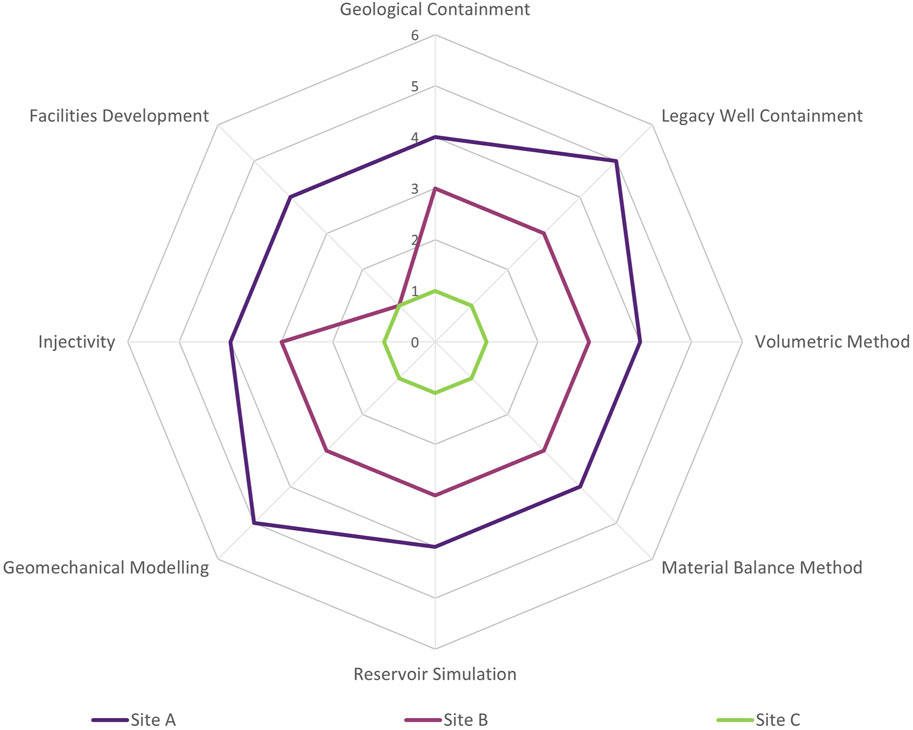
Figure 9. Site technical maturity by SRMS topic. Figures 1 through 7 and select text in this paper used with permission of Society of Petroleum Engineers (SPE), from A Novel Approach to Communicate a CO2 Storage Resources Management System Classification Framework, Chernik, PS., Caniggia, M., SPE-215752-MS, 2023; permission conveyed through Copyright Clearance Center, Inc.
The added benefit of a radial plot is that it allows multiple sites to be shown simultaneously. It provides an easy way to compare the progress. From Figure 9 we can see:
• Site A is the most advanced. All technical topics in Site A have gone through risk and uncertainty studies and a preliminary MMV and CM plan has been created, incorporating information from all 8 technical topics. Geomechanical Modelling and Legacy Well Containment work is further progressed than the other topics, and studies regarding risk in those two technical topics have concluded.
• Site B is actively studying the subsurface and wells. For these topics, the project proponent is working to understand risk and uncertainties. However, they have not completed any material facilities studies.
• Site C has just concluded the first screening stage. However, the project proponent has not determined if the necessary methodologies and tools exist to complete a full technical study on the site, in any of the eight technical topics.
This type of systematic visualization will aid internal and external stakeholders, particularly if widely adopted across CCS projects globally. Understanding how advanced technical work is, in various topics, will support effective communication, lead to more timely questions and help set expectations.
4 Discussion
In the author’s experience, there are inconsistencies in how CCS projects are currently evaluated, classified, and presented to stakeholders. This lack of consistency impacts stakeholders’ ability to compare one project to another.
This is partly because different guidelines and standards are currently in use worldwide. Universal adoption of the SPE SRMS to convey information on contingencies, uncertainties and commerciality could help provide more consistent information to stakeholders. The framework allows for risk to be addressed through classification, and uncertainty through categorization.
During the SRMS Contingent Resources phase a project, project proponents are active in identifying risks, quantifying risks and uncertainties and then developing MMV and CM plans to address residual issues. Yet the SRMS framework is proving insufficient to explain the pace of these efforts. The tools we describe in Sections 3.3–3.5 were designed to address this challenge.
The flowchart, six-step maturity framework, and radial visualization have provided a means to convey project progress, previously unavailable using the SRMS terminology and guidelines. They have allowed us to explain CCS project progress regarding technical topics in a more systematic way. In recent projects, the tools have also allowed us to frame the pace of technical study work, including the need for R&D, in emerging projects like CCS in coal-seams (Bergen et al., 2011; Singh et al., 2021). They are being used every day in an industrial setting, to address some of the communication challenges of the existing SPE SRMS guidelines. They have received positive feedback from stakeholders.
Additional research is required to support the tools proposed in this paper and ensure they are fit for purpose globally. The six-step maturity framework relies upon a need for a MMV and CM plan. Is it likely that MMV and CM plans will become the global norm? If not, what are alternatives to address residual risk? The entire toolkit proposed also relies upon best practice guidelines to support CCS professionals. Are guidelines such as ISO 27914 sufficient to define industrial best practices, especially as research evolves? If not, what should stakeholders expect of project proponents?
In addition, the tools in this paper only address technical contingencies. They ignore non-technical contingencies (Figure 4). Yet, non-technical contingencies have an equal role to play in project approval. A systematic way to convey progress in addressing non-technical risks would greatly benefit the CCS industry. This is a complex challenge that touches on topics such as the voluntary carbon credit market. (Verra, 2022), obtaining a social license to operate (Stronge et al., 2024) and legal considerations (Bankes et al., 2008).
It is an exciting time to be involved with CCS. As projects move from prospects to contingent resources to active storage sites, we will hopefully see CCS reach its potential as a critical mitigation measure in the fight against global warming. Tools, such as those described in this paper can help improve the consistency and clarity of information given to stakeholders, and help build trust in this emerging industry.
Author contributions
PC: Writing–original draft. MC: Writing–original draft. EM: Writing–original draft.
Funding
The author(s) declare that no financial support was received for the research, authorship, and/or publication of this article.
Acknowledgments
We would like to express our thanks to Rouha Hussaina, Sylvain Thibeau and Xavier Troussaut who provided feedback throughout the editorial process. We would also like to thank Harbour Energy for their support in publishing this paper and ERCE for their support throughout.
Conflict of interest
Author PC was employed by ERCE, Canada. Authors MC and EM were employed by ERCE, United Kingdom.
Publisher’s note
All claims expressed in this article are solely those of the authors and do not necessarily represent those of their affiliated organizations, or those of the publisher, the editors and the reviewers. Any product that may be evaluated in this article, or claim that may be made by its manufacturer, is not guaranteed or endorsed by the publisher.
Footnotes
1As an example see Canadian NI 51-101 Companion Policy (Canadian Securities Administrators, 2023, 5).
2It should be noted the guidelines referenced here are for reporting regarding contingencies preventing project approval, uncertainty in storage, and commerciality. They are designed with public disclosure and financing in mind. Additionally, there are regulatory guidelines and legal frameworks, that projects operate and report under, in each nation (Akerboom et al., 2021; National Energy Technology Laboratory, 2017; European Commission, 2023; EPA, 2024a; Alberta Energy Regulator, 2024; Australia DCCEEW, 2024).
3Project boundary definitions and the meanings of incremental projects in investment decisions is discussed in the SPE SRMS and SPE PRMS Guidelines.
4Note that the terms like MMV and Corrective Measures vary between jurisdictions. In the United Kingdom, the terms Monitoring Plan and Corrective Measures Plan are used.
5Classification and Categorization are key definitions described in Section 2 of the SRMS (see Figure 5). Classification, shown along the y-axis of Figure 5, is how projects are defined as either Prospective Storage Resources, Contingent Storage Resources or Capacity. This is effectively an assessment of project risk to achieve commerciality. Within these large classifications there are sub-classifications to provide more granularity as to the level of risk. Categorization, shown along the x-axis of Figure 5, is where estimates of the range of mass of CO2 that can be stored in the project are made. It is an assessment of uncertainty. For a full explanation, please refer to the SRMS.
6Values shown in Figure 9 are not from a real project.
References
AGRCC (2010). “The geothermal reporting Code,” in The Australian geothermal reporting Code committee. 2nd ed. Available at: https://www.dmp.wa.gov.au/Documents/Geological-Survey/Geothermal_Reporting_Code_Ed_2.pdf.
Akerboom, S., Waldmann, S., Mukherjee, A., Agaton, C., Sanders, M., and Kramer, G. J. (2021). Different this time? The prospects of CCS in The Netherlands in the 2020s. Front. Energy Res. 9. doi:10.3389/fenrg.2021.644796
Akhurst, M., Kirk, K., Neele, F., Grimstad, A.-A., Bentham, M., and Bergmo, P. (2021). Storage readiness levels: communicating the maturity of site technical understanding, permitting and planning needed for storage operations using CO2. Int. J. Greenh. Gas Control 110, 103402. doi:10.1016/j.ijggc.2021.103402
Alberta Energy Regulator (2024). Carbon capture, utilization, and storage. Available at: https://www.aer.ca/providing-information/by-topic/carbon-capture.
Alberta Government (2022). Monitoring, measurement and verification principles and objectives for CO2 sequestration projects. Available at: https://open.alberta.ca/publications/mmv-principles-objectives-for-co2-sequestration-projects (Accessed March 16, 2022).
ASX (2013). ASX listing rules guidance note 31 reporting on mining activities. Available at: https://www.asx.com.au/documents/rules/gn31_reporting_on_mining_activities.pdf.
ASX (2022). ASX listing rules guidance note 32 reporting on oil and gas activities. Aust. Secur. Comm. Available at: https://www2.asx.com.au/content/dam/asx/documents/unlinked-docs/compliance/gn32-reporting-on-oil-gas-activities-mark-up.pdf.
Australia DCCEEW (2024). Carbon capture, use and storage. Available at: https://www.dcceew.gov.au/climate-change/emissions-reduction/carbon-capture-use-storage (Accessed May 20, 2024).
Bankes, N., Poschwatta, J., and Mitchell Shier, E. (2008). The legal framework for carbon capture and storage in alberta. Alta. Law Rev. 2008.
Bergen, F. van, Tambach, T., and Pagnier, H. (2011). The role of CO2 -enhanced coalbed methane production in the global CCS Strategy. Energy Procedia 4, 3112–3116. doi:10.1016/j.egypro.2011.02.224
Bright, M. (2021). 45Q: the “most progressive CCS-specific incentive globally” is now open for business. Glob. CCS Inst. Available at: https://www.globalccsinstitute.com/news-media/insights/45q-the-most-progressive-ccs-specific-incentive-globally-is-now-open-for-business/ (Accessed March 24, 2021).
BTI Project (2024). BTI transformation Atlas. Available at: https://atlas.bti-project.org/1.
Canadian Securities Administrators (2015). “National instrument 51-101 standards of disclosure for oil and gas activities - consolidated version,” in Alberta Securities Commission. Available at: https://www.asc.ca/securities-law-and-policy/regulatory-instruments/51-101.
Canadian Securities Administrators (2016). “National instrument 43-101 standards of disclosure for mineral projects - consolidated version,” in Alberta Securities Commission. Available at: https://www.asc.ca/securities-law-and-policy/regulatory-instruments/43-101.
Canadian Securities Administrators (2023). “National instrument 51-101 standards of disclosure for oil and gas activities - consolidated version,” in Alberta Securities Commission. Available at: https://www.asc.ca/-/media/ASC-Documents-part-1/Regulatory-Instruments/2023/09/6110114--51-101-CP-Consolidation-Eff-June-9-2023.ashx.
CIM (2019). CIM estimation of mineral resources and mineral reserves best practice guidelines. Can. Inst. Min. Metallurgy Petroleum. Available at: https://mrmr.cim.org/media/1146/cim-mrmr-bp-guidelines_2019_may2022.pdf.
Delbert, L., Hjartarson, A., McDonald, I., McIlveen, J., Thompson, A., Toohey, B., et al. (2010). “The Canadian geothermal Code for public reporting 2010 edition,” in Canadian Geothermal Energy Association. Available at: https://www.cangea.ca/geothermal-code-for-public-reporting.html/:∼:text=Photos from Pixabay-, THE CANADIAN GEOTHERMAL CODE FOR PUBLIC REPORTING, geothermal resources and geothermal reserves.
DNV (2010). Independent project review (IPR) of storage component of the QUEST carbon capture and storage project. Canada: Det Norske Veritas Ltd. Available at: https://open.alberta.ca/dataset/46ddba1a-7b86-4d7c-b8b6-8fe33a60fada/resource/24814411-22e3-49d6-9766-1d5744ea1852/download/independentprojectreviewofstoragecomponentofccsproject.pdf.
DNV (2021). DNV-SE-0473 certification of sites and projects for geological storage of carbon dioxide. Available at: https://www.dnv.com/oilgas/download/dnv-se-0473-certification-of-sites-and-projects-for-geological-storage-of-carbon-dioxide.html (Accessed October, 2021).
EPA (2024a). Class VI - wells used for geologic sequestration of carbon dioxide. Available at: https://www.epa.gov/uic/class-vi-wells-used-geologic-sequestration-carbon-dioxide (Accessed July 16, 2024).
EPA (2024b). Subpart RR – geologic sequestration of carbon dioxide. Available at: https://www.epa.gov/ghgreporting/subpart-rr-geologic-sequestration-carbon-dioxide (Accessed August 6, 2024).
ESMA (2011). ESMA/2011/81 ESMA update of the CESR recommendations. Eur. Secur. Mark. Auth. Available at: https://www.esma.europa.eu/sites/default/files/library/2015/11/11_81.pdf.
ESMA (2013). ESMA update of the CESR recommendations the consistent implementation of commission regulation (EC) No 809/2004 implementing the prospectus direct. Eur. Secur. Mark. Auth. Available at: https://www.esma.europa.eu/sites/default/files/library/2015/11/2013-319.pdf.
Esser, J. (2021). The secret of adaptable organizations is trust. Harv. Bus. Rev. Available at: https://hbr.org/2021/03/the-secret-of-adaptable-organizations-is-trust (Accessed March, 2022).
European Commission (2023). Country reports on the implementation of the CCS directive. Available at: https://climate.ec.europa.eu/eu-action/industrial-carbon-management/deploying-industrial-carbon-management-europe/country-reports-implementation-ccs-directive_en.
European Commission (2024). Industrial carbon management. Available at: https://energy.ec.europa.eu/topics/carbon-management-and-fossil-fuels/industrial-carbon-management_en.
Global CCS Institute (2021). Global status of CCS 2021. Glob. CCS Inst. Available at: https://www.globalccsinstitute.com/wp-content/uploads/2021/10/2021-Global-Status-of-CCS-Report_Global_CCS_Institute.pdf.
Global CCS Institute (2023a). The government of the kingdom of Saudi Arabia joins the Global CCS Institute. Australia: Global CCS Institute Media Releases. Available at: https://www.globalccsinstitute.com/news-media/press-room/media-releases/the-government-of-the-kingdom-of-saudi-arabia-joins-the-global-ccs-institute/ (Accessed October 11, 2023).
Global CCS Institute (2023b). The Global Status of CCS: 2023. Australia: Global CCS Institute. Available at: https://res.cloudinary.com/dbtfcnfij/images/v1700717007/Global-Status-of-CCS-Report-Update-23-Nov/Global-Status-of-CCS-Report-Update-23-Nov.pdf?_i=AA.
Harbour Energy (2023). Viking CCS project. Harb. Energy. Available at: https://www.harbourenergy.com/safety-esg/viking-ccs/.
Holloway, S. (1996). Final report of joule II project No. CT92-0031 the underground disposal of carbon dioxide. JOULE Programme Sub-Programme Non Nucl. Energy. Br. Geol. Surv. Available at: https://nora.nerc.ac.uk/id/eprint/502763/1/Joule%20II%20final%20report.pdf.
IEA (2022). CCUS legal and regulatory database. Available at: https://www.iea.org/data-and-statistics/data-tools/ccus-legal-and-regulatory-database (Accessed July 7, 2022).
IEA (2023). Tax incentive for carbon capture storage. Available at: https://www.iea.org/policies/17250-tax-incentive-for-carbon-capture-storage (Accessed May 17, 2023).
International Organization for Standardization (2017). ISO 27914:217(E) carbon dioxide capture. Transp. Geol. Storage - Geol. Storage.
JORC (2012). The JORC Code. Jt. Ore Reserv. Comm. Available at: http://www.jorc.org.
Kennedy, B., and Moore, A. (2023). “SRMS in the UKCS - from a license application to a CCS permit and beyond,” in Presented at the SPE Aberdeen and GESGB CCUS Conference 2023, Virtual, October 3–6, 2023. Available at: https://www.ges-gb.org.uk/events/ccus-conference-2023/.
LSE (2009). AIM note for mining, oil and gas companies. Lond. Stock Exch. Available at: https://docs.londonstockexchange.com/sites/default/files/documents/aim-notice-16.pdf.
Metz, B., Davidson, O., de Coninck, H., Loos, M., and Meyer, L. (2005). Carbon dioxide capture and storage: working group III of the intergovernmental Panel on climate change. Cambridge University Press. Available at: https://www.ipcc.ch/report/carbon-dioxide-capture-and-storage/.
National Energy Technology Laboratory (2017). Best practices manuals. Available at: https://netl.doe.gov/carbon-management/carbon-storage/strategic-program-support/best-practices-manuals.
National Renewable Energy Laboratory (2021). GeoRePORT protocol and spreadsheet template. Geotherm. Data Repos. doi:10.15121/1572375
NOD (2024). Guidelines for license applications, award of area for storage of CO2 2024-2 on the Norwegian continental shelf. Nor. Offshore Dir. Available at: https://www.sodir.no/globalassets/1-sodir/fakta/co-to/tillatelser/nr-2-2024/eng/guidelines-for-application-ccs-2024-2.pdf.
NOVATEK (2022). NOVATEK obtains international certification for CO2 underground storage sites in yamal and gydan. Available at: https://www.novatek.ru/en/press/releases/index.php?id_4=4861 (Accessed February 3, 2022).
NPD (2001). Guidelines to classification of the Petroleum resources on the Norwegian continental shelf. Nor. Pet. Dir.
NSTA (2022). Measurement, monitoring and verification (MMV) of carbon capture and storage (CCS) projects with Co-location considerations. United Kingdom: North Sea Transition Authority (NSTA) News and Publications. Available at: https://www.nstauthority.co.uk/news-publications/publications/2022/measurement-monitoring-and-verification-mmv-of-carbon-capture-and-storage-ccs-projects-with-co-location-considerations/ (Accessed August 1, 2022).
NSTA (2023). Guidance on the application for a carbon dioxide appraisal and storage licence rev 1.1. Available at: https://www.nstauthority.co.uk/media/8146/cs-licence-guidance-final-29-april-2022.pdf.
Pilot Energy (2024). Major increase to cliff head carbon storage resource. Available at: https://www.pilotenergy.com.au/sites/default/files/asx-announcements/61213758.pdf (Accessed July 1, 2024).
Reeves, M., Haanaes, K., and Sinha, J. (2015). Your strategy needs a strategy. Boston, MA: Harvard Business Review Press.
Ryan, T. (2022). How business can build and maintain trust. Harv. Bus. Rev. Available at: https://hbr.org/2022/02/how-business-can-build-and-maintain-trust (Accessed February, 2022).
SEC (2009). Federal register, 17 CFR parts 210, 211. Modernization of oil and gas reporting: final rule. Fed. Regist. Secur. Exch. Comm. 74 (9), 2158–2197.
Shapira, A., and Horsager, D. (2022). To win over an audience, focus on building trust. Harv. Bus. Rev. Available at: https://hbr.org/2022/03/to-win-over-an-audience-focus-on-building-trust (Accessed March, 2022).
Shukla, P. R., Skea, J., Slade, R., Khourdajie, A. Al, van Diemen, R., McCollum, D., et al. (2022). Climate change 2022: mitigation of climate change. Contribution of working group III to the sixth assessment report of the intergovernmental Panel on climate change. Cambridge University Press. Available at: https://report.ipcc.ch/ar6wg3/pdf/IPCC_AR6_WGIII_Citation.pdf.
Singh, U., Sharma, N., and Dunn, J. B. (2021). Revisiting geologic storage potential in unconventional formations is key to proactive decision making on CCS in India. Front. Clim. 3. doi:10.3389/fclim.2021.708320
SPE (2017). CO2 storage resources management system. United States: Society of Petroleum Engineers. Available at: https://www.spe.org/en/industry/co2-storage-resources-management-system/.
SPE (2018). Petroleum resources management system. United States: Society of Petroleum Engineers. Available at: https://www.spe.org/en/industry/petroleum-resources-management-system-2018/.
SPE (2022). Guidelines for applications of the CO2 storage resources management system. United States: Society of Petroleum Engineers. Available at: https://www.spe.org/en/industry/co2-storage-resources-management-system/.
Stronge, D. C., Kannemeyer, R. L., and Edwards, P. (2024). Building social licence to operate: a framework for gaining and maintaining meaningful, trustworthy relationships. Resour. Policy 89, 104586. doi:10.1016/j.resourpol.2023.104586
The Financial Services Authority (2002). The listing rules. Financ. Serv. Auth. Available at: https://www.fca.org.uk/publication/ukla/listing-rules-august-2002.pdf.
The University of Edinburgh (2021). Climate change: carbon capture and storage. Available at: https://www.edx.org/course/climate-change-carbon-capture-and-storage (Accessed October, 2021).
UK DESNZ (2023a). Carbon capture, usage and storage an update on the business model for transport and storage - explanatory note and indicative heads of terms. United Kingdom: Department for Energy Security and Net Zero. Available at: https://assets.publishing.service.gov.uk/media/6581d936fc07f3000d8d4517/ccus-heads-of-terms-december-2023-412234454.1.pdf.
UK DESNZ (2023b). Carbon capture, usage and storage (CCUS): business models. Available at: https://www.gov.uk/government/publications/carbon-capture-usage-and-storage-ccus-business-models (Accessed October 17, 2023).
UNECE (2016). Specifications for the application of the united nations classification for fossil energy and mineral reserves and resources 2009 (UNFC-2009) to injection projects for the purpose of geological storage. Task Force Appl. UNFC-2009 Inject. Proj.
UNECE (2020). United nations framework classification for resources - update 2019. U. N. ECE Energy Ser. (61).
UNFCCC (2023a). FCCC/PA/CMA/2023/L.17, outcome of the first global stocktake. United Arab Emirates: United Nations Framework Convention on Climate Change. Available at: https://unfccc.int/sites/default/files/resource/cma2023_L17_adv.pdf.
UNFCCC (2023b). Nationally determined Contributions (NDCs). U. N. Clim. Change. Available at: https://unfccc.int/ndc-information/nationally-determined-contributions-ndcs (Accessed February 3, 2023).
Verra (2022). Area of focus - carbon capture and storage. Area Focus - Carbon Capture Storage (blog). Available at: https://verra.org/programs/verified-carbon-standard/area-of-focus-carbon-capture-storage/.
Viking CCS (2023). Viking CCS. Available at: https://www.vikingccs.co.uk/.
Vitasek, K., Manrodt, K., and Ledlow, G. (2022). 3 ways to build trust with your suppliers. Harv. Bus. Rev. Available at: https://hbr.org/2022/11/3-ways-to-build-trust-with-your-suppliers (Accessed November, 2022).
Wang, J., Yue, Z., Zhengzhen, An, and Ali, S. (2022). CO2 storage in carbonate rocks: an experimental and geochemical modeling study. J. Geochem. Explor. 234, 106942. doi:10.1016/j.gexplo.2021.106942
Wilson, C., Hattingh, S., Peacock, D., and Zhang, T. (2023). The framework and practice of CO2 storage resources evaluation: Santos moomba CCS project CO2 storage resources assessment. APPEA J. 63 (May), S478–S482. doi:10.1071/AJ22275
Wintershall, D. (2020). Milestone for CCS project greensand reached. Available at: https://wintershalldea.com/en/newsroom/milestone-ccs-project-greensand-reached (Accessed November 26, 2020).
Nomenclature
Keywords: CCS, SRMS, SPE storage resource management system, competent person, stakeholder reporting, CCS risk and uncertainty reporting, carbon capture and storage reporting
Citation: Chernik PS, Caniggia M and Mitchell E (2024) Effective communication in an emerging CCS industry – an application of the SPE SRMS to convey contingencies, uncertainties, commerciality, and progress to project approval. Front. Energy Res. 12:1459830. doi: 10.3389/fenrg.2024.1459830
Received: 04 July 2024; Accepted: 26 August 2024;
Published: 13 September 2024.
Edited by:
Qiang Sun, Xi’an University of Science and Technology, ChinaReviewed by:
Benjamin Emmel, SINTEF, NorwayChen Chen, Qingdao University of Science and Technology, China
Copyright © 2024 Chernik, Caniggia and Mitchell. This is an open-access article distributed under the terms of the Creative Commons Attribution License (CC BY). The use, distribution or reproduction in other forums is permitted, provided the original author(s) and the copyright owner(s) are credited and that the original publication in this journal is cited, in accordance with accepted academic practice. No use, distribution or reproduction is permitted which does not comply with these terms.
*Correspondence: Paul S. Chernik, cGNoZXJuaWtAZXJjZS5lbmVyZ3k=
 Paul S. Chernik
Paul S. Chernik Matteo Caniggia
Matteo Caniggia Ellen Mitchell
Ellen Mitchell